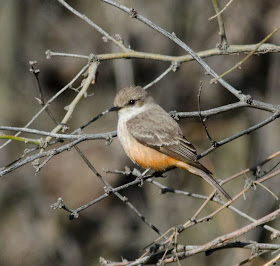Sunday was the last day of the weekend and so I tried to choose my destination carefully. I had decided to hit some of the spots on the Salt River and I picked Coon Bluff as my first spot due to the fact that a Facebook friend (Kathy Gonzales) had gotten some wonderful photos of some Bald Eagles. As it turned out I spent my entire morning there and never went to any of the other places as I was having such a good time. I found 41 species of birds in that small area and some were very colorful, starting with the Vermilion Flycatchers, male and female.
Vermilion Flycatcher-male
Vermilion Flycatcher-female
And while we are still looking at flycatchers, I also discovered an Ash-throated Flycatcher and a Gray Flycatcher, so it was a 3 flycatcher day for me. (OK, the Gray Flycatcher did not want to cooperate for photos, but always a nice find even if they are not so colorful.) Later this spring and summer, the Ash-throated Flycatchers will be abundant and raising young here in Arizona.
Gray Flycatcher
Ash-throated Flycatcher
This place is probably the best place to find and observe the Phainopepla which belongs to the family of Silky Flycatchers and is the only member of this family that can be seen in the United States. The males are jet black and the females are gray, both with white wing patches, seen when flying and both have red eyes. They do catch a lot of insects in flight, but in the winter months they feed on the berries of the mistletoe.
Phainopepla-female
Phainopepla-male
And we are not through with the colorful birds; how about some more red and maybe a yellow bird while we are at it. Had a pair of Northern Cardinals in the area, but only the male was allowing photos on this day. And the trees were full of Lesser Goldfinches, which are a bit more subdued than the American Goldfinch, but those males in breeding plumage are pretty darn sharp. (The Lesser Goldfinch has recently been hanging around my backyard feeders. Took them a while to find it, but now it is a constant source of food for them.)
Northern Cardinal
Lesser Goldfinch
Now we come to the reason why I chose this place first, the Bald Eagles. They were not there early, but showed up about mid morning. They flew in and landed on the rocks above the river. One adult and 2 juveniles blessed us with their presence. It takes 4 years for a Bald Eagle to obtain its famous white head and tail. Juveniles are mostly brown with varying area2 of white. Of the 2 juveniles, I think one of them is a 2nd year bird and the other a 3rd year bird. So here are my photos of the Bald Eagles perched high up on the rocks overlooking the Salt River.
Bald Eagle-juvenile, maybe a 2 year bird
Bald Eagle-juvenile, maybe a 3 year bird
Bald Eagle-adult
Bald Eagle-adult
As you can see, I was having a pretty good time at this recreation site and it was packed full of campers. I think they all thought I was a bit nuts walking around with my binoculars and a camera, but I bet most of them never even saw the bright red Vermilion Flycatchers or Cardinal, or the bright yellow of the Lesser goldfinches. A few did notice the Bald Eagles, but some of the smaller birds are packed with color and character, so they are missing a lot!












Great post Gordon. Wow, what awesome Bald Eagle shots!
ReplyDeleteDang Gordon, super sharp shots!
ReplyDeleteI was at Coon Bluff on Saturday, just the day before : )
It's such a marvelous place, and right now seems to be the best birding along the Salt River. You got some stellar looks at those Eagles. Awesome.